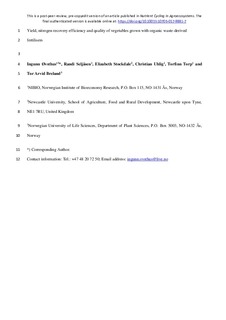| dc.contributor.author | Øvsthus, Ingunn | |
| dc.contributor.author | Seljåsen, Randi | |
| dc.contributor.author | Stockdale, Elizabeth | |
| dc.contributor.author | Uhlig, Christian | |
| dc.contributor.author | Torp, Torfinn | |
| dc.contributor.author | Breland, Tor Arvid | |
| dc.date.accessioned | 2018-01-04T13:54:02Z | |
| dc.date.available | 2018-01-04T13:54:02Z | |
| dc.date.created | 2017-10-04T14:56:05Z | |
| dc.date.issued | 2017 | |
| dc.identifier.citation | Nutrient Cycling in Agroecosystems. 2017, 109 (3), 233-248. | nb_NO |
| dc.identifier.issn | 1385-1314 | |
| dc.identifier.uri | http://hdl.handle.net/11250/2475741 | |
| dc.description.abstract | More sustainable production of high-quality, nutritious food is of worldwide interest. Increasing nutrient recycling into food systems is a step in this direction. The objective of the present study was to determine nitrogen (N) fertiliser effects of four waste-derived and organic materials in a cropping sequence of broccoli, potato and lettuce grown at two latitudes (58° and 67° N) in Norway during three years. Effects of anaerobically digested food waste (AD), shrimp shell (SS), algae meal (AM) and sheep manure (SM) at different N application rates (80 and 170 kg N ha–1 for broccoli, and 80 and 60 kg N ha–1 for potato and lettuce, respectively) and residual effects were tested on crop yield, N uptake, N recovery efficiency (NRE), N balance, N content in produce, mineral N in soil, product quality parameters and content of nitrate in lettuce. Mineral fertiliser (MF) served as control. Effects on yield, N uptake, NRE, N balance and product quality parameters could to a great extent be explained by estimated potentially plant-available N, which ranked in the order of AD>SS>SM>AM. Results for crops fertilised with AD and SS were not significantly different from MF at the same N application rate, while AM, in agreement with its negative effect on N mineralisation, gave negative or near-neutral effects compared to the control. No residual effect was detected after the year of application. The results showed that knowledge about N dynamics of relevant organic waste-derived fertilisers is necessary to decide on the timing and rate of application. | nb_NO |
| dc.language.iso | eng | nb_NO |
| dc.rights | Attribution-NonCommercial-NoDerivatives 4.0 Internasjonal | * |
| dc.rights.uri | http://creativecommons.org/licenses/by-nc-nd/4.0/deed.no | * |
| dc.title | Yield, nitrogen recovery efficiency and quality of vegetables grown with organic waste-derived fertilisers | nb_NO |
| dc.type | Journal article | nb_NO |
| dc.type | Peer reviewed | nb_NO |
| dc.description.version | acceptedVersion | nb_NO |
| dc.source.pagenumber | 233-248 | nb_NO |
| dc.source.volume | 109 | nb_NO |
| dc.source.journal | Nutrient Cycling in Agroecosystems | nb_NO |
| dc.source.issue | 3 | nb_NO |
| dc.identifier.doi | 10.1007/s10705-017-9881-7 | |
| dc.identifier.cristin | 1502276 | |
| dc.relation.project | Norges forskningsråd: 176767 | nb_NO |
| cristin.unitcode | 192,10,2,0 | |
| cristin.unitname | Institutt for plantevitenskap | |
| cristin.ispublished | true | |
| cristin.fulltext | postprint | |
| cristin.qualitycode | 1 | |

